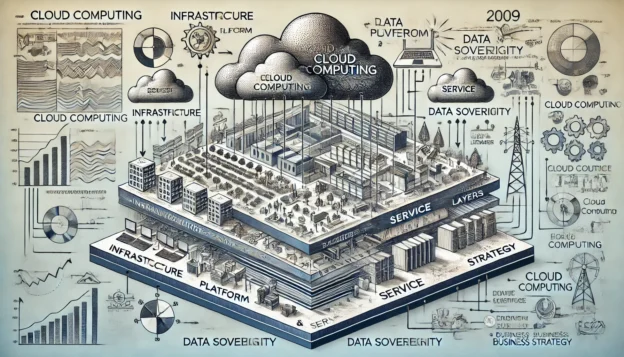This article revisits a 2009 cloud computing panel discussion at the ‘Entrepreneur Country’ event, hosted by Julie Meyer, examining how the ideas and predictions shared during the event have influenced the evolution of cloud computing over the past 15 years. It reflects on the entrepreneurial context of the time, the adoption and maturity of cloud services, legal and regulatory challenges, and the future vision for cloud technology, offering insights into the lessons learned and their relevance today.
Introduction
In February 2009, I participated in a panel discussion on cloud computing at the ‘Entrepreneur Country’ event, a significant gathering of entrepreneurs, VCs, and startups, hosted by Julie Meyer of Ariadne Capital. This event served as a rallying cry for innovation during the economic recession, highlighting the critical role of entrepreneurs in driving economic recovery. The event featured keynotes from notable figures like Sir Paul Judge and Edward Wray, and brought together leading entrepreneurs who shared insights on starting and growing businesses during tough economic times.
Then: The Entrepreneurial Context
The event’s atmosphere was one of optimism and determination, despite the recession. Entrepreneurs like Roman Stanek and Gerry Ford emphasised resilience and the opportunities that challenging times create for building robust companies. The event also included discussions on cloud computing, where I, along with Charles Black and Kolvin Stone, explored how this emerging technology could be leveraged by startups and larger enterprises alike.
We discussed the convergence of technologies, the economic necessity driving cloud adoption, and the growing familiarity and openness towards cloud-based solutions. These themes resonated with the entrepreneurial spirit of the event, which was focused on capitalising on innovation to overcome economic challenges. Key discussions and insights included:
- Adoption and Maturity: The panel examined why cloud computing was different this time, focusing on technological convergence, economic necessity, and growing familiarity with cloud services. At the time, the consensus was that cloud computing was on the cusp of widespread adoption, driven by factors such as high-speed broadband and the demand for scalable, cost-effective IT solutions.
- Corporate Adoption: We discussed the pressures influencing corporate CIOs to adopt cloud services, drawing parallels with past technological revolutions like the PC and Internet booms. Internal demands from business units and external competitive pressures were seen as key drivers for cloud adoption, with CIOs needing to balance innovation with risk management.
- Legal and Regulatory Issues: The panel touched on the “undiscovered country” of legal issues related to cloud computing, such as data ownership, IP rights, and compliance. There was a general agreement that legislation would be reactionary, evolving as cloud adoption grew.
- Future Vision: I shared my vision for the future of cloud computing, predicting the rise of standardisation, agent-based computing, and the continued evolution of the web. The idea was that cloud services would become more integrated, with fewer infrastructure build-outs and more direct service offerings over the cloud.
Now: Reflections and Realities
Fifteen years later, the optimism about cloud computing has largely been validated. The technology has matured, becoming a fundamental part of the IT infrastructure for businesses worldwide. The concerns about legal and regulatory issues that were raised during the panel have become central to cloud strategy today, particularly regarding data sovereignty and compliance.
However, the predictions about seamless corporate adoption faced hurdles, especially in sectors like financial services, where legacy systems and stringent regulations slowed the transition to the cloud. Despite these challenges, cloud computing has become integral to business strategy, enabling companies to scale rapidly and innovate continuously.
A Look Back and Forward
Revisiting the discussions from the 2009 panel provides a valuable perspective on how far cloud computing has come and the foresight that was required to navigate its early days. The entrepreneurial energy from the ‘Entrepreneur Country’ event, combined with the strategic insights shared during the panel, laid a foundation for understanding the potential and challenges of cloud computing.
As we look to the future, the lessons from that time remind us of the importance of resilience, adaptability, and continuous innovation. These qualities are as crucial today as they were during the economic recovery of the late 2000s, especially as we navigate the ongoing evolution of cloud computing and its impact on business and technology.
Conclusion
Reflecting on the panel discussion and the broader ‘Entrepreneur Country’ event, it’s clear that the ideas and predictions from 2009 have significantly shaped the cloud ecosystem we know today. The intersection of entrepreneurship and cloud technology has driven much of the innovation and growth over the past 15 years, and as we continue to advance, the lessons from these early discussions will remain relevant in guiding future developments.
References
- Cloud Computing panel interview with Sun Microsystems at ‘Entrepreneur Country’
- Sun Microsystems, Cloud Computing and the premier European VC event ‘Entrepreneur Country’
- Cloud Relationship Model
- Revisiting the Cloud Computing Model: A 15-Year Reflection
- Julie Meyer Personal Website
- Julie Meyer on LinkedIn
- Julie Meyer on Wikipedia
- Edward Wray on LinkedIn
- Edward Wray on Nesta
- Edward Wray on Twitter
- Sir Paul Judge on Wikipedia
- Sir Paul Judge Obituary at The Independent
- Sir Paul Judge Obituary at the Livery Companies
